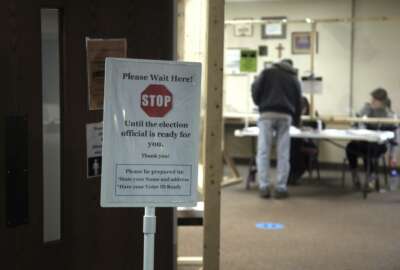
Problems with the Payroll Protection Program
However well intentioned, the Payroll Protection Program has issues. Federal Drive discussed them with Akin Gump attorney, Samantha Block.
Best listening experience is on Chrome, Firefox or Safari. Subscribe to Federal Drive’s daily audio interviews on Apple Podcasts or PodcastOne.
Like all trillion dollar legislation debated and passed within days, the CARES Act and its spawn, the Payroll Protection Program, have got problems, you might say. However well intentioned, the PPP has issues. For a few specific suggestions, Federal Drive with Tom Temin turned to judicial law clerk for the U.S. Court of Federal Claims, and former Akin Gump attorney, Samantha Block.
Interview transcript:
Tom Temin: Good to have you on.
Samantha Block: Thank you so much for having you, Tom.
Tom Temin: So first of all, as a judicial clerk for the US Court of federal claims, something we hear from quite a bit in this particular market, and a former Akin Gump attorney, what is your interest in of all things, the payroll protection program?
Samantha Block: Yes. So I am the daughter of a small business owner and the past few weeks I have put up with my parents trying to apply for this loan and having lots of difficulty and being concerned about paying for their employees, how they’re going to keep their business running. And so I got really interested in learning more about it and I’m the only attorney in the family so of course, I’m the one they turn to when they have questions about Anything law related?
Tom Temin: All right, well, that’s a good, good way to bring you into this. And so you have a lot of suggestions in the article for law 360. And first of all, tell us what some of the difficulties have been from the standpoint of a user that SBA should be aware of, since this kind of got dumped on them in a very short period of time, a lot of money and a lot of workload.
Samantha Block: Yeah. So I think the first major difficulty was it was a first come first serve in getting this funding out, which was well intentioned to get the money into the economy. But as a user, it was very difficult to get funds. My parents applied the day came out, and they actually did not get funds in the first round. Because it was very difficult to fill out the application. It was unclear if the application was submitted, you had to find a bank that you were already an account holder with because the banks were putting their own restrictions on what loans they would process despite no restrictions being in the original bill, and then figuring out how the forgiveness works, determining whether or not you know a lot of small businesses don’t have in house attorneys to explain how the forgiveness works. So is it worth taking advantage of a loan that you might not be eligible for? So the vague rules constantly put my parents on edge on whether or not they should rescind their loan application for fear that if they got it, where they going to be refunded the money and they didn’t want to be liable for anything that they could not afford in the future.
Tom Temin: Sure. Would you mind giving us just a sense of how big the small business is, how many employees and what the nature of it is?
Samantha Block: So my dad’s a podiatrist, so he has his own practice and he had to stay open because people still get injured. And he has, I believe, six employees. Doesn’t seem like much but when your small, and you have to still pay for them, but you’re not having as many patients coming in so you’re not getting as much money and doctors don’t get paid immediately. Usually you get reimbursed a month or two months later. It was very scary time on how they’re going to keep their employees employed and be able to continue to see patients.
Tom Temin: All right, so podiatrist jumping into the payroll protection plan with both feet, you might say. One of your suggestions is to change that 75-25 rule. And that was something that I think started out at 100%. And so there was a little bit of improvisation that seemed going on by SBA to try to get what the balance of payroll expenses versus everything else would be to have the loans forgiven. So what’s your thought there?
Samantha Block: So it seems a little bit of an arbitrary number, in my opinion, it’s trying to put a one size fits all approach to small businesses. And there’s that span various industries. And a lot of businesses aren’t able to run at full capacity right now due to state regulations and federal regulations such as restaurants, and we’re requiring them to have 75% of their payroll still, that’s where their expenses are going. So it didn’t really make sense. But there’s actually a new bill, the Payroll Protection Program Flexibility Act that was just passed in the House and should be voted on, likely this week in the Senate. And that actually would lower the amount to 60%, which makes more sense for a lot of businesses. But the issue there is that it’s unclear that partial forgiveness will be an option under the current law, should you not reach the 75% payroll requirement, your forgiveness can be reduced by the amount that you fail to satisfy. But under the new flexibility act, it seems to indicate that the limitation on forgiveness is limited to you actually reaching that 60% threshold. So that’s something that should be clarified because there should be the option for partial forgiveness because again, not all businesses are running at full capacity. And instead, we’re forcing these businesses to work as an unemployment office by rehiring employees just to get the loan to rehire them.
Tom Temin: And this other idea that you’re proposing is to lower the maximum loan size. Tell us about the thinking behind that.
Samantha Block: So currently, the maximum loan size was $10 million and in the first round of funding 4% of the loans were for over a million dollars, but that dried up 44% of the available funds, which is a big reason why the funds were gone in 13 days. So clearly the Treasury has indicated that loans over $2 million are suspect, and they have promised to fully audit these loans. So rather than use these resources to audit these loans, why not just cap the loan at $2 million, and then more loans can be given to more businesses. And it’s more likely that the smaller businesses are the ones that will be getting the loans because they’re more likely to need less. So I would suggest to cap it at $2 million, which is what the Treasury seems to think is a appropriate amount.
Tom Temin: And one other suggestion would seem to be the obvious thing since this does come from the Small Business Administration, and that is to prioritize small business, although we know some very large businesses have gotten loans. And so tell us what your specifics are on that one.
Samantha Block: So the government has tried to help small businesses And the second round of funding they earmark 60 billion for small banks and small community banks. But small bank does not mean small business small banks do help large businesses. So rather than focusing on the lender, I would suggest you focus on the borrower. And I don’t think it’s necessary to say that businesses over 300 employees are not eligible rather make it a queue and put them further back in the queue and first process the loans for businesses with under 50 employees and process loans with businesses under 100 employees just to ensure that the smaller businesses are getting the loans and maybe currently the lenders have made over $10 billion in processing fees, and they get a percentage of the loan amount. Instead, it should just be a flat fee that would incentivize them to do more loans if they’re getting a flat fee for each loan and likely process smaller loans because it’s easier.
Tom Temin: I guess, if they had six months to set this up, they might have come up with all of these answers and thought about it but they did not so just to you know, to their credit to SBA was trying to do that. can in very, very short amount of time. And then I wanted to finally cover the definition of key terms, which you say are those that cause confusion. And that’s something that is within the agency’s control for how it defines those words. What are some of those?
Samantha Block: There’s been some confusion. And again, I don’t fault the SBA at all, they got this program out very fast, and it’s impressive what they did with what they had. But there’s a lot that has, you know, there’s left to be desired. And some of the key terms for example, is what exactly is forgiven and tax deductible for example, the loan, the actual loan, those funds are not tactical gross income, but then it was silent on what happens to the, with the expenses that the funds are used for, are those taxable, and the IRS came out and clarified for the SBA and said that those are not tax deductible, even though typically payroll utilities are tax deductible, so they want to prevent double dipping, but it would seem that Congress actually didn’t look at this as double dipping, but instead want to ensure that these small businesses had the capital to weather the storm.
Tom Temin: And how were the loan application questions? Those were confusing? I think we’ve mentioned that in the beginning.
Samantha Block: Yes. So the loan application questions are very confusing. It’s an 11 page application to get your loan forgiven. And you have to do some complex math to determine how much is forgiven. What expenses are covered. The SBA continues to release more information on what’s covered, they’ve clarified what constitutes full time equivalent employees for your calculation. So they’re trying to help small businesses understand how to apply but an 11 page application for a small business that doesn’t have an in house attorney to help them is difficult.
Tom Temin: Sounds like they took some lessons from the IRS. Samantha Block is an attorney and judicial law clerk for the US Court of federal claims. Thanks so much for joining me.
Samantha Block: Thank you so much for having me. I really enjoyed it.
Copyright © 2025 Federal News Network. All rights reserved. This website is not intended for users located within the European Economic Area.
Tom Temin is host of the Federal Drive and has been providing insight on federal technology and management issues for more than 30 years.
Follow @tteminWFED
Related Stories





